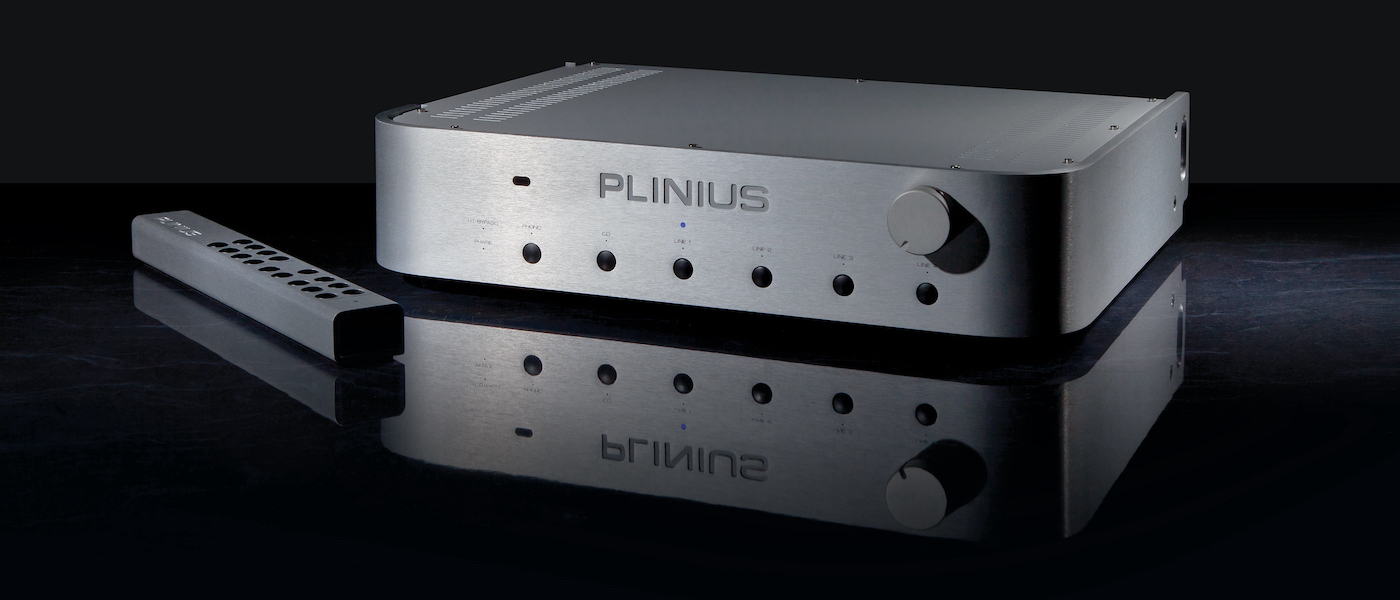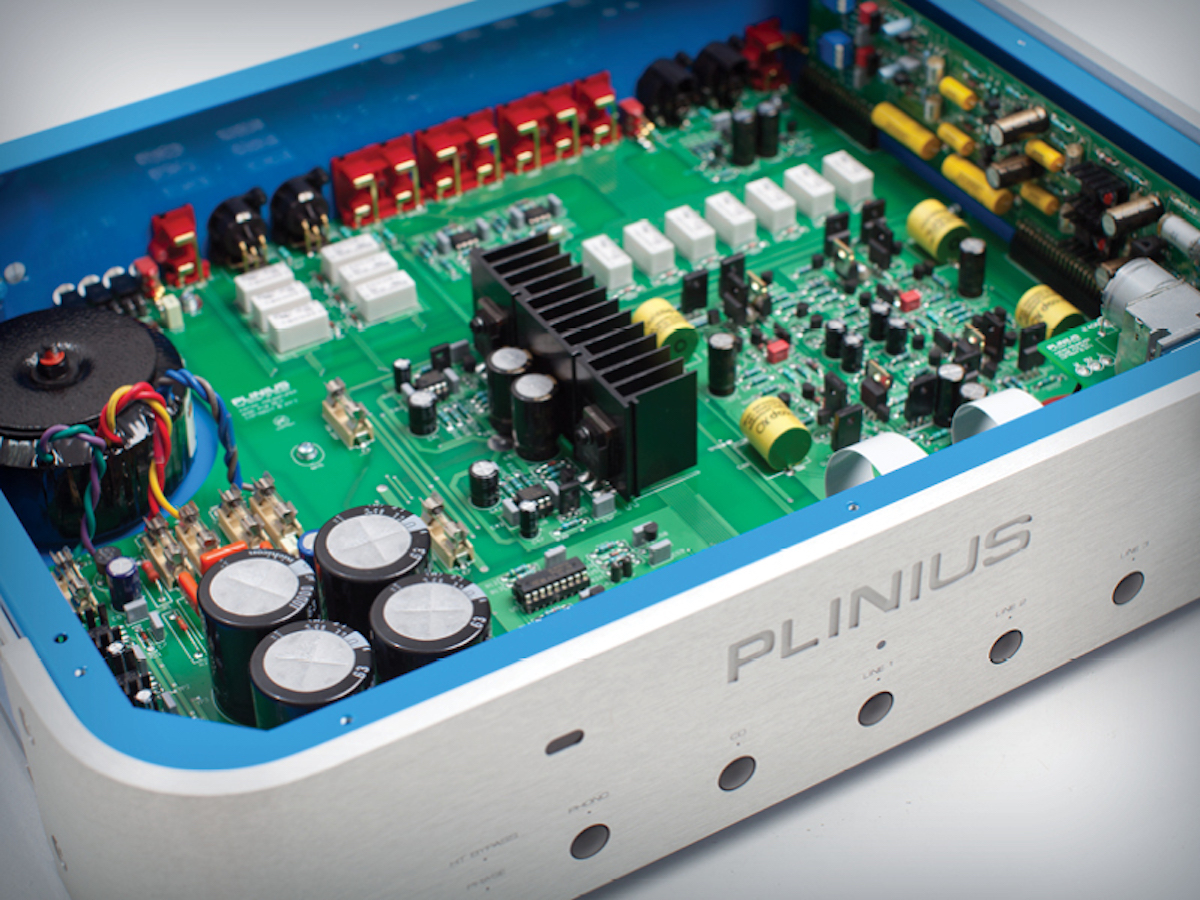And it made me realize my stereo system is capable of much greater sound quality than I ever thought possible.
Plinius Kaitaki Preamplifier Highlights
- Exceptionally transparent.
- Can be configured with an internal phono stage for $650.
- Home theater throughput.
- Full-function remote control.
- Line Out feature to connect to a recording unit, headphone amplifier, or other accessories.
Plinius Audio Limited is based in New Zealand and was founded in 1980. Their current product names derive from Māori culture. The word Kaitaki describes the concept of guardianship for the sky, the sea, and the land. That name makes sense for a preamplifier, which sits at the center of a music or home theater system. I had never seen or heard of a Plinius component, so when the opportunity arose to review the Kaitaki preamplifier I couldn’t say no. Little did I know how much of a surprise it would be?
Inputs/Outputs:
5 x RCA Line Inputs
1 x XLR/RCA selectable Line Input
1 x RCA HT Bypass Input
1 x RCA Output
1 x XLR Output
1 x Line Out
Trigger:
In/Out
Features:
Remote RC5 In
Ground Lift Switch
Optional Phono Input
Full-function remote control
Available in black or silver
Frequency Response:
20Hz to 20kHz +/-0.2dB
Distortion:
<0.05% THD at rated input level
Signal to Noise Ratio:
-80dB at rated input level, A-weighted
Input Sensitivity for Rated Output:
125mV RMS Unbalanced inputs 62mV RMS Balanced inputs
Input:
50k ohms
Rated Pre-Out Level:
500mV RMS into 10k ohms or higher
Pre-Out:
Minimum Recommended Load: 47k ohms
Line Out Level:
190mV at 200 ohms
Output Source:
Typically, 100 ohms
Gain:
Line Amplifier: 12dB
Power/Current Consumption:
40W / 0.10A (23W)
Phono Input (Optional):
Input Capacitance: 100pF
Gain:
60dB, 66dB
Load:
47k ohms, 470 ohms, 100 ohms, 47 ohms, 22 ohms
Frequency Response:
20Hz to 20kHz ±0.2dB, within RIAA specification Signal to Noise Ratio: -80dB wrt 5mV input, A-weighted
Distortion:
<0.01% THD at all levels below clipping
Dimensions:
Height: 4 inches (105mm)
Width: 17.75 inches (450mm)
Depth: 15.75 inches (400mm)
Weight:
20lbs (9kg)
MSRP:
$6250 ($6900 with the optional phono option)
Warranty:
Five years
Website:
SECRETS Tags:
Plinius, preamplifier, Plinius reviews, remote control, preamplifier reviews 2023
The Kaitaki follows the design language employed by Plinius throughout their current line of products. The face of each of their components is a single sheet of brushed metal with curved edges, available in black or silver. The company’s name is etched prominently in all caps in the center, and the indicator lighting is blue and white LEDs. The back panel and chassis are glossy medium blue with gray text. I find this aesthetic extremely attractive. Also, all of the unit’s panels are non-magnetic, to reduce unwanted magnetic fields that can interfere with sensitive audio signals.
Auricap XO capacitors are used in key areas of the Plinius Kaitaki’s circuit. These were chosen for their clarity and dynamic ability. Auric OFC wire is used in the input stage of the unit’s amplifier. The Kaitaki line stage power supply regulation circuit and line stage amplification circuits are very similar in design to the Plinius Hiato, the big brother integrated amplifier to the Kaitaki. This circuit design has helped keep alive the “Plinius sound” which has been described as slightly warm, with tube-like smoothness in the mid-range and lifelike bass detail and control.
Thanks to its numerous inputs and outputs, the Plinius Kaitaki can act as the centerpiece in a wide range of home theater or music systems. It also has a Line Out feature, so you can connect it to recording units or a headphone amplifier. It has terminals for remote trigger connections to allow a processor signal to bypass the preamplifier stage or trigger a power amplifier to come out of standby. Another nice feature is a ground lift switch, which allows for the signal ground to be isolated from the main chassis earth. This can assist in resolving unwanted ground loops or hum due to duplicate ground paths in some systems. Single-ended and balanced output connectors are standard.
For an extra $650, the Plinius Kaitaki can be configured with a phono stage based on the Plinius Hautonga design. The phono stage has two gain settings and five loading settings to allow for suitable cartridge matching. If you don’t need the phono stage, the input can be used as an additional single-ended line-level input. If you prefer an external phono stage, Secrets reviewer Rick Schmidt recently reviewed the Plinius Koru phono preamp and found it to be most excellent.
The remote deserves its own review.
The included remote control is massive. It’s twelve inches long and feels quite substantial in the hand. It’s also made of the same brushed silver metal as the preamp’s faceplate. On its back is a black grippy material to keep it from sliding around. It is so big I actually felt like I was holding a magic wand when I used it.

You can use the remote’s Display button to set the brightness of the source indicator lights on the face of the unit. There are four levels, including completely off, which is nice, but you cannot turn off the unit’s blue indicator light. When muted, the blue light is dimmed, and when unmuted, the blue light is brighter. Another great feature is that there is a Phase button to toggle the output signal from the preamplifier from absolute (in-phase) to inverted 180 degrees. That’s nice to have for stereo recordings which are mastered with the left and right channels reversed.
The remote’s buttons are not backlit, so it is difficult to know which button to press in the dark unless you memorize their locations. The remote control is truly a beautiful object, befitting the price and design of the Plinius Kaitaki, but I believe its usability could use some improvement.
With an MSRP of $6500, the Plinius Kaitaki preamplifier is the most expensive component I’ve ever had in my system. The preamplifier I’ve been using since 2020 is the Schiit Audio Freya+, which sells for $849. So yeah, big price difference.
After removing it from its box, I read the excellent manual provided by Plinius. It is clearly written and includes the signature of the person who performed the unit’s final test certification. This is exactly the kind of documentation and test assurance I’d expect of a component in this price range.
It’s worth noting that the Plinius Kaitaki was delivered with a standard-quality IEC power cord. Because that is what it was shipped with, that’s the power cord I used to first put the Plinius Kaitaki in my system. I connected my Orchard Audio Starkrimson Stereo Ultra amplifier with Zu Audio Mission XLR cables, which were driving a pair of Polk Audio Legend L600 speakers with bi-wired cables.
The digital source I used was an Oppo UDP-205 attached to a Schiit Audio Bifrost 2 DAC through a digital coax cable. The Bifrost 2 was connected to the Plinius Kaitaki with a Zu Audio Mission XLR cable. The preamp has both RCA and XLR inputs for its CD source, and you use a toggle switch to tell the Plinius Kaitaki which to use. However, you are not supposed to attach both RCA and XLR at the same time.
So, with the Kaitaki integrated into my system, I sat down and played a CD. And did I hear a difference in sound quality? Oh yes, I did, and I heard it immediately. There was an expansion of soundstage I’d never heard before, and the increase in low-level musical detail startled me. The Orchard Audio Starkrimson Stereo Ultra is a particularly detailed and fast amplifier in my system, but the Plinius Kaitaki enabled even more of those qualities to make it to the speakers. A noticeable amount of smearing of 3D imaging and soundstage movement was gone, so the timing of notes felt more authentic, and instruments were much easier to place in the soundstage. And I experienced this through literally everything I played through the Plinius Kaitaki preamplifier. It felt as though a layer of fog on the window through which I listened to the music was completely erased. This of course led me to quite a few sessions when I listened to familiar recordings and sat amazed at all the new detail I was hearing.
Using the Plinius Kaitaki with tube amplifiers
After some time listening with a solid-state amp, it was time for some tubes. I used the Plinius Kaitaki with my McIntosh MC30 push-pull tube amps and Spatial Audio M3 Triode Master speakers. This was also a big surprise. Whether with digital or analog sources, I heard more bass, and more bass detail, than I thought possible with these amps and speakers. Over the years I have learned that it’s not always correct to just assume a speaker is incapable of producing particular frequencies well, especially bass. It’s just that the speaker isn’t receiving those particular frequencies available in the recordings from the source components. The musical information is there in the recording, but the preamplifier or amplifier may prevent them from making it to the speakers. So, naturally, if the preamp can’t let those bass frequencies get to the speakers, then the speakers cannot play those bass frequencies. This has been a major eye-opener for me, and the Plinius Kaitaki drove that point home even further. It enabled much more musical information from my sources to make it to the speakers than I’ve ever heard. So now I want better source components that can send more information to the speakers through the Plinius Kaitaki. Such is the way of the journey to superior sound reproduction.
A word about the power cable
After listening to the Plinius Kaitaki with its stock power cable for a few weeks, I figured it was worth listening to it with a higher-quality cable, so I installed a Zu Mission power cable. The improvement was immediately apparent, with an improvement in sound quality across the entire frequency range, in particular with a focus on bass energy and upper ranges. Needless to say, I did not go back to using the stock power cable. I do not hold it against Plinius for including a low-priced power cord with this preamplifier, because, I believe, a person who can pay around $7,000 for a preamplifier either already has a quality power cable on hand or can easily purchase one. So, it is my recommendation to ditch the stock power cable and experiment with higher-quality power cables.

Tori Amos “Strange Little Girls”
Tori Amos, “Strange Little Girls” (CD, Atlantic 7567-83486-2, 2001)
I’ve used this CD as a reference recording for quite some time, and the Plinius Kaitaki enabled me to hear details I never knew were there. For example, her cover of 10CC’s “I’m Not In Love” moved from being just a song to being an entire location. I heard so much more spatial information I came to believe that Amos wanted the listener to think the song was recorded in a dungeon. There are subtle and distant sounds that appear and disappear throughout the soundstage, as though there were tortured souls crying out in lament in different cells of the dungeon. The spatial cues lead me to believe Amos is in a dark room made completely out of stone. At some point in the song, I could have sworn I heard a train in the distance. The Plinius Kaitaki enabled me to experience the song much more deeply.

André Previn And His Pals “West Side Story”
André Previn And His Pals, “West Side Story” (LP, Contemporary Records S7572, 1960)
Because the Plinius Kaitaki was delivered to me without its optional phono option, I used my Ray Samuels Audio Emmeline F-117 Nighthawk phono preamplifier. The cartridge I used is a Denon DL-103 mounted on a Jelco SA-750LB 12-inch tonearm, and the turntable is a grease-bearing Garrard 301. For this album, pianist André Previn’s pals were Shelly Manne on drums and Red Mitchell on bass. It was recorded at Contemporary Record’s studio in Los Angeles, California, in 1959, and was engineered and recorded by the great Roy DuNann, who also recorded Sony Rollins’s “Way Out West” album in the same studio with the same drummer a mere seven months later. I think André Previn was an absolutely incendiary jazz pianist, and his arrangements of Leonard Bernstein’s “West Side Story” songs are eye-opening and entertaining. The interplay between the three musicians is intimate and easy to follow and quite humorous at times. And just like the Sonny Rollins album, the clarity of the soundstage and instrument placement is amazing. All of these qualities were readily apparent when played through the Plinius Kaitaki preamplifier with both the tube and solid-state amplifiers.

Roger Waters “The Lockdown Sessions”
Roger Waters, “The Lockdown Sessions” (24-bit/96kHz streaming via Qobuz)
This gets my vote for one of the best albums of 2022, and, as can be expected from Roger Waters, the quality of the recording is very good. There are six songs; two are from Waters’s solo albums and four from Pink Floyd albums and the rearrangements Waters did for them are surprisingly fresh. Every second of the album is satisfying, but most satisfying for me is the new arrangement of “Comfortably Numb.” It is slow, mournful, thoughtful, and better than I could ever imagine this already perfect song to be. The recording is spacious and well-mixed, and the background vocals in particular really stand out. When played through the Orchard Audio Starkrimson Stereo Ultra amplifier and Plinius Kaitaki preamplifier, I could easily distinguish between the voices of the different women, and the instrument timbre was authentic. Waters does employ some of his audio tricks throughout the album, and he used sounds in “Comfortably Numb 2020” which really grab your attention. The Plinius Kaitaki enabled me to feel the full impact of those audio tricks each time I listened to the album.
The Plinius Kaitaki enabled me to hear the most lucid, transparent sound I’ve ever experienced in my system. It also made me realize that the rest of my system is capable of a quality of fidelity I didn’t know it was capable of. It is an attractive, solid, and well-built component that’s built to last a very long time. If I could easily afford it, I would buy it without reservation. The Plinius Kaitaki is a preamplifier I will miss quite a bit after I return it.
- Exceptionally transparent sound.
- Very attractive design.
- High number of inputs.
- Home theater throughputs.
- Can be integrated with other Plinius components.
- Backlighting for the remote control





